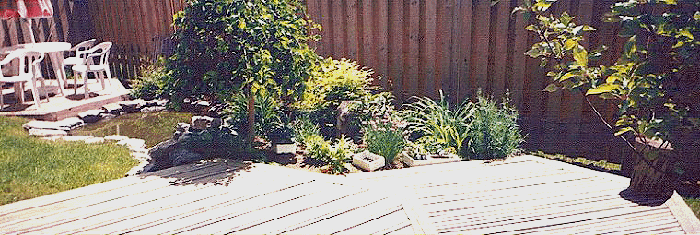"Help me! I've fallen and I can't get up!" A line from a Broadway
musical, and from Frances over the phone early one summer seven
years ago. She and Howie (her husband) had bought a new home from
a model, and a diagram of its position in a development layout
plan. An avid gardener, Frances had opted for the larger triangular
corner lot. The surprise came with the final grading of the lot.
The back yard was not only a truncated right-angle triangle, it
consisted entirely a 30 degree slope (the maximum local bylaws
allow). The choice was basically whether you wanted to tip over
on the lawn chair, or slide off it!
Other design challenges included a second floor balcony off the
main living space (with stairs down to the garden), public leeways
on two sides and a common drainage swale along the back, and the
fact that it was quite small and sunny. The useable (nonpublic)
area was roughly 26 x 41 feet. |
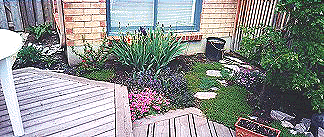 |
|
After talking to everyone in the family, I also discovered that
Frances, Howie and their three active teenage children all had
different demands for the back yard. (Thank god, no dog!) The
major ones of these were:
- flat areas for seating and outdoor dining;
- privacy;
- appropriate for large-scale entertaining
- low maintenance - not too much grass, but enough for suntanning
- and as extensive planting beds as possible.
- a water feature
- a design which was appealing from the balcony overview of the garden.
In other words, it was a lot to work into one small space.
|
I took as my starting point the basic interior design approach of the house itself- multiple levels, often within an open concept. Rather than creating one large deck surface which would have overwhelmed the small space, I began to develop smaller deck areas, large enough for four to six people, occasionally screened off from other areas with plantings. For the north side of the garden that allowed me to stagger down a series of small decks and avoid any major re-working of the slope, critical to the water flow design that the developer had incorporated into the entire site. |
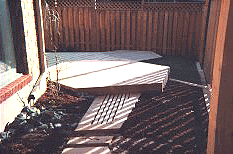 |
|
The major design feature was that most of the decks were hexagonal in shape, built of 6 x 6 pressure treated pine, with the top of each surfaced with varying widths of wood: including 2 x 6, 2 x 4, and 2 x 2. The paths and auxiliary decks were complimentary angular structures, all again surfaced in wood of varying widths (predominantly 2 x 2). The substantial use of smaller dimensions not only emphasized the variety of the deck surfaces, but allowed the incorporation of a very delicate element into what would have been an overly heavy graphic composition. The overall effect was to create large graphic components of considerable interest, both at ground level and especially from the the balcony point of view.
|
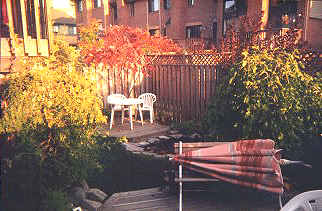 |
|
In order to create the flat area required for a water feature,
the south side of the garden did, however, require considerable
alteration of the slope. I chose to increase it starting after
a small flat area at the base of the stairs by digging down some
three feet.
I
resisted introducing more stairs which would have overly
|
|
| |
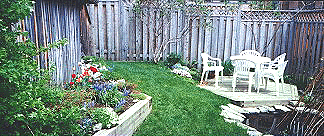 |
|
complicated
the design; rather I simply created a grassy link between
the stairs and the two deck areas, and one which flowed to the
pond area. A small but useable area of flat grass was also created.
The grassy slope was flanked by a loose rock retaining wall and
rock garden, which as the lawn flattened out became a 6 x 6 retaining
wall for a raised bed high enough to provide a comfortable sitting
area. The earth from this area was used to create a hill in the
center bottom of the garden which came up to the main deck level:
another loose rock retaining 'wall' was constructed to hold back
the hill, and to provide an area for a small stream to run down
and into the pond.
|
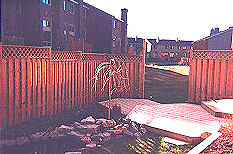 |
|
The pond itself was an informal, elongated oval which visually
connected the solitary deck at the southwest corner of the garden
to the main multi-level deck area. "Howie's deck", as it came
to be known, formed one edge of the pond and was destined to be
one of the shadiest area of a very sunny garden. A short rock
retaining wall was required at the back of the pond area to further
flatten the area for the pond.
Behind this retaining wall, and all along the back of the fence,
a deep channel was dug to sink the developer's storm swale beneath
the level of the garden. It flowed into the side of the storm
drain rather than into the top as originally intended, just outside
the northwest corner of the fence. It was filled with crushed
rock, geocloth (to keep out the soil) and topped with more aesthetic
rounded pebbles and rocks. Creepers would eventually top at least
part of this rocky end of the garden.
|
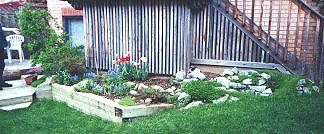 |
|
The second floor balcony (6 x 10) was filled in to ground level with a custom screen of vertical 2 x 2 cedar (to match existing construction), and included a door in the same style. High enough to comfortably walk into, the 'room' was intended as a enclosed garden storage and potting area.
|
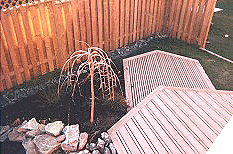 |
|
An interesting side effect of the design in this sunny location was to create very distinct microclimates for each of the planting beds: a sandy desert at the edge of the house by the main deck, a sunny well drained area at the foot of the second storey balcony, a partially sunny slope flanking the pond, and three areas of (eventually) shade varying from very dry to very moist soil conditions. While the planting spaces are small (to a country gardener, at least), they provide a great deal of challenge and allow for a wide variety of plant species to be incorporated in to the garden.
|
 |
| Frances' garden utilized admittably more intricate design features than can affordably incorporated into most designs - unless of course, you are doing the bulk of the work! The advantage is, of course, you end up with a unique garden space that remains visually interesting over the long term. And remains a challenge and a pleasure to garden in.
|
|

